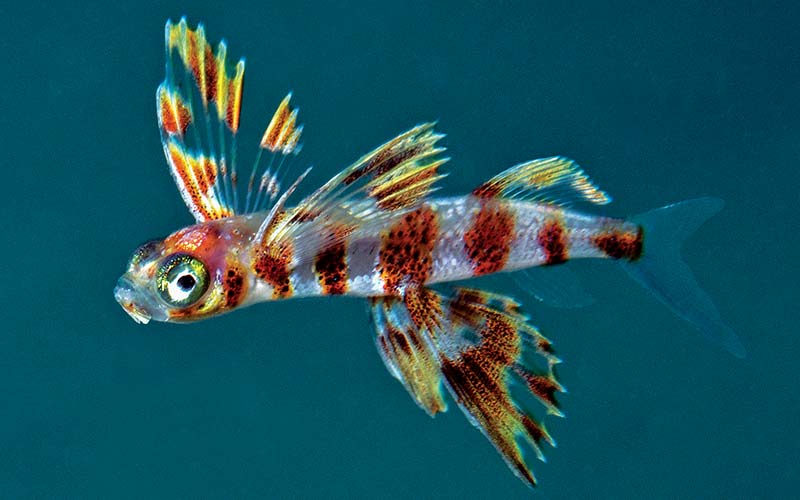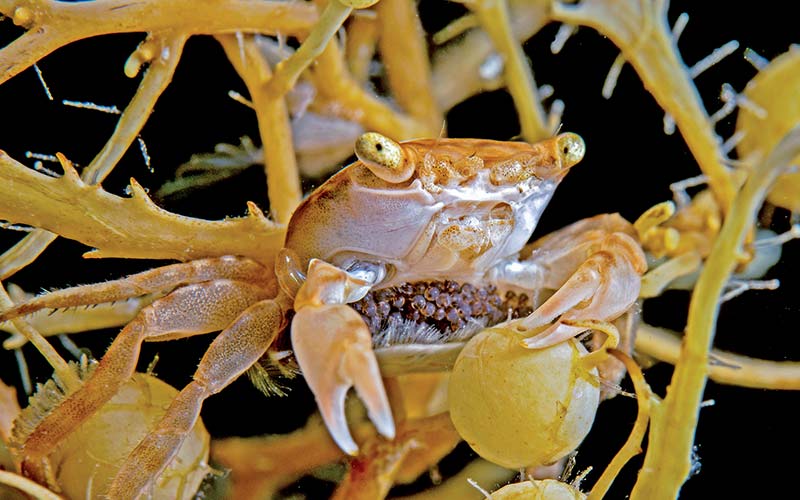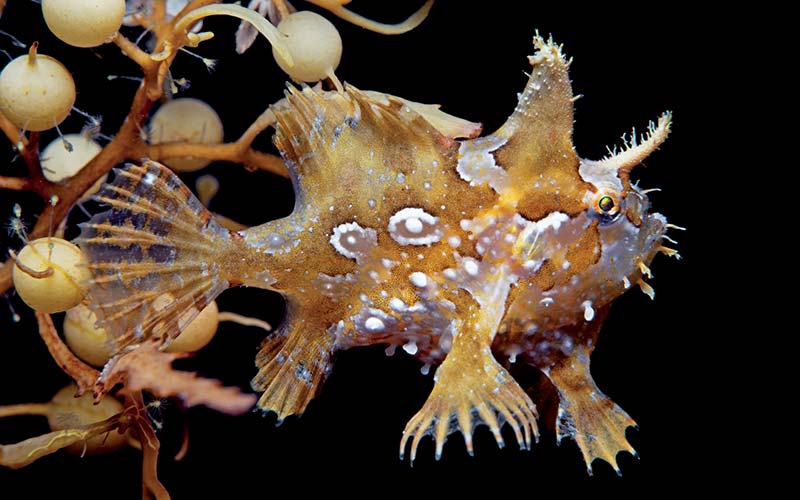It couldn’t be a better December day to be on the water in Bermuda. The easterly winds had dropped to a whisper during the night, and the sun, rising bright and full of promise, begins to take the edge off the early morning chill as our skiff skirts Nonsuch Island and breaks toward open sea. Chris Flook, manning the wheel, and I are after dolphinfish. Rather than pursuing the prized four- to five-foot monsters regularly taken from these waters, we’re on an even more challenging adventure: We’re out to photograph the predators’ two- to three-inch juveniles that hang around floats of sargassum seaweed this time of year. But first we have to find them.
I couldn’t have a better guide or companion than Chris, a native Bermudian who has spent his life on the water and worked as the collector of specimens at the Bermuda Aquarium for nearly two decades. And we couldn’t be in a better location for our hunt than Bermuda. Rising out of the Atlantic some 700 miles east of the Carolinas, the isolated, 21-square-mile string of islands sits on the western fringe of the Sargasso Sea.

The Sargasso Sea is a huge swath of the central Atlantic the size of the U.S., where within the calm vortex of four clockwise currents two species of floating algae from genus Sargassum have been growing in profusion for 30 million years; some claim it is the largest organism on Earth. Storms regularly tear rafts of the algae free to sail east with the wind toward Bermuda, carrying a cargo of animals along for the ride. The fauna includes a diverse nursery of juvenile fishes and invertebrates accompanied by an unconventional community of endemic species that have evolved to live nowhere else.
From my perch on an ice chest surrounded by buckets, nets and assorted dive gear, I listen as Chris explains why he decided to run so far offshore. “Those drifts we passed back in the bays have been pretty much picked over by now. We’ll take advantage of the weather to find some fresh weed to ….” He stops midsentence, pointing directly ahead. “There — that’s what we’re after.” I’m up on my feet following the lead of his finger. A quarter-mile off the bow a blanket of gold spreads across the horizon. Within minutes we’re running alongside a bobbing mat of algae the size of a tennis court.
“Perfect, perfect,” Chris mutters. Keeping his eyes on the water, he cuts the engine and slowly reaches for a long-handled net. A quick sweep, and the net comes up dripping. “Bingo,” he chuckles, spilling his catch into a pail of seawater. A transparent and beautiful juvenile flying fish the size of my thumbnail skitters about the surface.

“Good start,” he proclaims with a grin..
“A sensational start,” I blurt back from on my knees, unable to take my eyes off the frilly-finned fish in the bucket.
“Check out the edges — that’s where the young predators patrol.” No sooner has Chris finished the sentence than I’m leaning over the gunnels inspecting the surface.
A half-hour later three more tiny flying fish buzz in the bucket, but a dolphinfish has yet to make an appearance. “OK, enough of that for now. Let’s see what we can find in the mat.” With that Chris scoops up a net full of weed. After he shakes out the contents, the white nylon netting shimmers with twitching shrimp and scurrying crabs — each in its own way a replica of its floating home. Along with the legions of crustaceans, tiny fish occasionally tumble out of the tangles — first a puffer and then a triggerfish followed by white-spotted Bermuda chub. The dipping, shaking and sorting is exhilarating. I feel like I’m eight years old again, turning over stones in a West Texas creek. Even though Chris grew up with these animals and knows their names and nature by heart, it’s obvious they still bring him the same joy as when he was a carefree kid on the loose.
Miniature marvels keep coming in, including the most iconic of the endemics: a sargassumfish — a master of camouflage and concealment. Once in the bucket the bizarre little frogfish makes a break for a float of weed, where it vanishes. A pair of pipefish and a sargassum nudibranch join our menagerie, but a dolphinfish is not to be found.

A glance at our watches snaps us back to reality. It’s well past our scheduled time to head back, and all it takes is one look into the buckets to know how much photographic work we have ahead. But Chris refuses to give up the search for a dolphinfish, slowly hunting a spindrift of sargassum all the way back to Nonsuch, but still with no luck. He guides the skiff into a calm bay and angles the bow toward a sargassum-lined beach, where we plan to photograph the animals.
“Well, what do we have here?” Chris asks under his breath as he picks up the net and with a quick dip brings in a dolphinfish — a two-inch capstone to one of the best fishing trips of my life.
© Alert Diver — Q2 Spring 2013